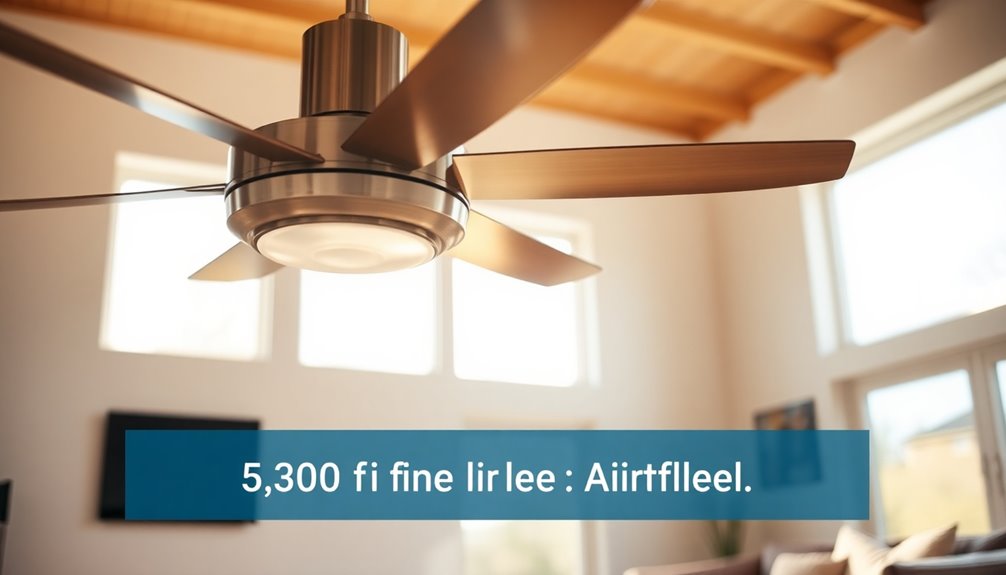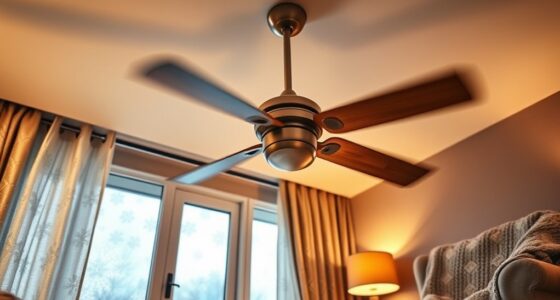To determine the right ceiling fan size for your room, start by measuring its dimensions. For small spaces up to 100 sq ft, choose a fan with a 29-36 inch blade span. Medium rooms between 100-225 sq ft benefit from a 36-44 inch fan, while larger areas of 225-400 sq ft need a 50-54 inch fan. If your room exceeds 400 sq ft, consider a 60-inch fan or multiple units. Don't forget to check your ceiling height and the potential need for downrods to guarantee proper air circulation. There's plenty more to explore about fan features and installation.
Key Takeaways
- Measure your room's square footage: use length x width to find the total area for accurate fan size determination.
- For rooms up to 100 sq ft, use fans with a 29-36 inch blade span; for 100-225 sq ft, choose 36-44 inches.
- Larger rooms (225-400 sq ft) require fans with 50-54 inch spans, while those over 400 sq ft may need 60 inch fans or multiple units.
- Ensure the fan is installed at least 7 feet above the floor for optimal airflow and safety; use downrods for higher ceilings.
- Consider blade pitch and number for airflow efficiency; a steeper pitch and appropriate blade count enhance cooling performance.
Measuring Room Dimensions

When choosing the right ceiling fan for your space, measuring your room's dimensions is vital. Start by measuring the length and width of your room from wall to wall. This will help you calculate the total square footage. For instance, if your room measures 12 feet by 15 feet, you've got a total area of 180 square feet (12 x 15 = 180 sq ft).
If you're dealing with an L-shaped room, divide the space into two rectangles, calculate each area separately, and then sum the results for an accurate measurement.
Accurate room size measurement is important because it determines the appropriate ceiling fan size for effective air circulation. Standard recommendations suggest that a fan with a span of 36 to 50 inches works well for rooms around 12×12 feet. This guarantees you achieve maximum airflow, keeping your space comfortable.
Understanding Ceiling Fan Span

After measuring your room's dimensions, the next step is understanding the ceiling fan span. The blade span is essential for determining your fan's air-moving capacity and ensuring you achieve the best cooling efficiency.
Here's what you need to know about fan sizing:
- Measure the Blade Span: For even-numbered blade fans, measure directly across from tip to tip. For odd-numbered fans, find the radius by measuring from the tip to the center, then double that measurement for the diameter.
- Match Fan Size to Room Square Footage: Ceiling fan sizes generally range from 29 inches to over 71 inches. Fans with larger spans (50 inches or more) are perfect for rooms over 400 square feet, while smaller spans (29-36 inches) work well in spaces up to 100 square feet.
- Ensure Effective Air Circulation: Accurate measuring of a ceiling fan helps you select the right ceiling fan size, contributing to effective air circulation and energy efficiency in your room.
With these guidelines, you'll be well-equipped to choose the perfect ceiling fan for your space!
Ceiling Height Considerations

How high should your ceiling fan be installed for the best performance? Ideally, you want the fan blades to be about 8 feet from the floor, which guarantees optimal air circulation while keeping safety in mind.
If your ceiling height is under 8 feet, consider a low-profile or flush mount fan. This prevents airflow blockage and maintains a comfortable environment.
For standard ceiling heights, typically ranging from 8 to 9 feet, aim for a minimum clearance of 7 feet between the blades and the floor.
If your ceiling exceeds 9 feet, you'll need to use downrods to achieve the proper hanging height. This is vital for effective air circulation, and common downrod lengths vary between 12 to 36 inches based on your specific ceiling height.
If your ceiling is sloped, you may need an angled mounting kit to guarantee the fan remains level and operates efficiently.
Calculating Downrod Length

Properly calculating downrod length is vital for maximizing your ceiling fan's performance. If your room has a ceiling height over 9 feet, you'll need a downrod to guarantee the fan is installed at the ideal height for air circulation, ideally between 8 to 9 feet from the floor.
Here's how to determine the right downrod length:
- Measure your ceiling height: This is fundamental to understand how far your fan will hang.
- Account for fan housing height: The typical height of fan housings ranges from 8 to 12 inches. This measurement will impact your total downrod length.
- Determine the desired blade height: For effective airflow, the blades should ideally be 8 feet above the floor. For example, in a 10-foot ceiling, a 12-inch downrod is recommended to achieve this blade height. Additionally, maintaining the proper air quality in your room can enhance the overall comfort and effectiveness of the ceiling fan.
Always consult specific charts that relate ceiling heights with appropriate downrod lengths to guarantee proper installation. Additionally, selecting a fan with high-performance ratings ensures that it operates efficiently in various climates.
Remember to regularly assess the downrod length requirements when changing ceiling heights or fan models to maintain effective airflow and safety.
Fan Size Recommendations

When picking a ceiling fan, it's essential to take into account your room size and the appropriate blade span.
For small spaces, you'll want a fan between 29 and 36 inches, while larger areas need something 52 inches or more.
Knowing these guidelines will help you guarantee efficient airflow and comfort in your home.
Room Size Guidelines
Choosing the right ceiling fan size is essential for guaranteeing ideal airflow in your space. Proper fan size not only enhances air circulation but also contributes to your overall comfort.
Here are some room size guidelines to help you select the perfect fan:
- Up to 100 Square Feet: For smaller rooms, opt for a ceiling fan with a blade span of 29 to 36 inches. This size guarantees adequate airflow without overwhelming the space.
- 100 to 225 Square Feet: In medium-sized rooms, choose a fan with a blade span of 36 to 44 inches for maximum cooling efficiency. This fan size will effectively circulate air, maintaining a comfortable environment.
- 225 to 400 Square Feet: Larger rooms require a ceiling fan with a blade span of 50 to 54 inches. This size will adequately manage air circulation and keep the space comfortable.
For rooms over 400 square feet, consider fans with a blade span of 60 inches or more, or even multiple fans, to guarantee consistent airflow.
Blade Span Considerations
Determining the right blade span for your ceiling fan is essential for maximizing airflow and comfort in your space. For rooms up to 100 square feet, you should look for a ceiling fan with a blade span between 29 to 36 inches. This size guarantees effective air circulation without overwhelming the area.
If your room measures between 10×12 to 12×14 feet, a fan with a 44-inch blade span is ideal for best airflow and comfort.
For larger spaces exceeding 14×16 feet, you'll need a fan with a blade span of 52 inches or more to provide adequate cooling. In areas over 400 square feet, think about installing multiple fans, as one fan may not suffice for effective air circulation.
Properly sizing the ceiling fan according to your room dimensions enhances energy efficiency, helping you save on electricity bills while maintaining a comfortable environment.
Choosing the right ceiling fan sizes guarantees you're not left with a fan that's too small to cool effectively or too large, leading to unnecessary energy consumption. Make sure to take these recommendations into account for the best results!
Mounting Options for Fans

Mounting your ceiling fan correctly is vital for maximizing its efficiency and guaranteeing safety. You have several mounting options to evaluate based on your ceiling height and structure. Here are three popular choices:
- Flush Mount: This option is great for low ceilings, allowing you to install the fan directly against the ceiling. It typically needs 6-10 inches of clearance, guaranteeing safe operation without obstructing the fan blades.
- Downrod Mounting: Ideal for ceilings higher than 8 feet, downrod mounting uses a rod to extend the fan down to the recommended 7-9 feet above the floor. This setup enhances air circulation, providing a better cooling effect in your room.
- Angled Ceiling Mount: If you have angled ceilings, you'll need an angled-ceiling adapter to guarantee the fan is positioned correctly for effective airflow.
Before making your choice, confirm that your ceiling structure can support the fan's weight and check for any potential obstacles that could block the fan blades.
Choosing the right mounting option is vital for maximum performance and comfort in your space.
Blade Design and Functionality

While the aesthetics of a ceiling fan are important, its blade design greatly influences both airflow efficiency and overall performance.
When choosing a fan, reflect on the blade pitch, which typically ranges from 12 to 15 degrees. A steeper angle can greatly enhance air movement, making your space feel more comfortable.
You'll also want to think about the number of blades. Fans can have between 4 to 9 blades; more blades generally provide quieter operation, but they may reduce airflow efficiency compared to fans with fewer blades.
Don't overlook blade shape either. Wider blades create a broader airflow pattern, while narrower blades can focus air in a specific area, which might be beneficial depending on your room layout.
Another feature to reflect on is reversible blades. These allow you to change the look and functionality of your fan without needing a complete replacement, giving you versatility in design and performance.
Energy Efficiency Factors

When choosing a ceiling fan, understanding energy efficiency factors can save you money.
Pay attention to fan efficiency ratings and remember to change the blade direction with the seasons to maximize comfort and savings.
With the right size and maintenance, you can enjoy significant energy cost reductions year-round. Additionally, selecting fans with energy star ratings can further enhance your savings potential.
Fan Efficiency Ratings
Energy efficiency is an essential aspect to take into account when selecting a ceiling fan, as it directly impacts both your comfort and utility bills.
To guarantee you choose a fan that fits your needs, consider the following factors:
1. CFM Rating: Look for a fan with a CFM Rating of 4,000 or higher for larger spaces. This rating measures airflow efficiency per watt consumed, which means higher values equal better efficiency.
If the CFM rating is below 2,000, you mightn't get enough cooling power.
2. DC Motors: Opt for fans with DC Motors, as they're typically more energy-efficient. They can consume up to 70% less energy than traditional AC motors while still providing similar airflow.
3. Blade Pitch: The Blade Pitch is vital for fan efficiency. Aim for a pitch of 12 to 15 degrees, which optimizes airflow and can help you rely less on air conditioning.
Seasonal Direction Changes
Choosing the right ceiling fan goes beyond just its efficiency rating; it also involves understanding how to maximize its performance throughout the year.
One key aspect is making seasonal direction changes. In summer, set your fan's ceiling fan blades to spin counterclockwise. This creates a cooling effect, generating a wind-chill sensation that can make your room feel up to 8 degrees cooler. By doing this, you can reduce your reliance on air conditioning and enjoy significant energy savings.
As the cold months approach, remember to reverse the fan's direction to clockwise at a low speed. This adjustment helps circulate warm air trapped near the ceiling, enhancing your heating efficiency and overall comfort.
Regularly changing the direction of your fan guarantees ideal air distribution, keeping your home cozy in winter and cool in summer.
Energy Cost Savings
Ceiling fans can significantly cut your energy costs by improving airflow and enabling you to adjust your thermostat settings. By creating ideal air circulation, you can enjoy a comfortable environment without relying solely on heating and cooling systems.
Here are three ways ceiling fans can save you money:
- Higher Thermostat Settings: In summer, you can raise your thermostat by a few degrees while still feeling cool, potentially saving you up to 30% on cooling bills.
- CFM Efficiency: Choose a ceiling fan with a higher CFM (Cubic Feet per Minute) rating for better air movement. This increased airflow enhances energy efficiency and keeps your comfort level consistent.
- Smart Controls: Implementing smart home technology allows you to control your ceiling fan's speed and operation based on occupancy and temperature, ensuring effective energy use. Additionally, incorporating energy-efficient designs in your home can further optimize your energy savings.
Properly sizing your ceiling fan is essential; a fan that's too small may lead to higher energy costs as you crank up your AC.
Additionally, reversing your fan in winter helps distribute warm air, further lowering heating expenses.
With the right ceiling fan, you'll enjoy both comfort and savings year-round.
Aesthetic Considerations

When selecting a ceiling fan, aesthetics play a crucial role in achieving a harmonious look in your space. The design and color of the fan should complement your existing room decor, enhancing the overall ambiance.
Consider the blade shape and number; traditional designs with 4 to 9 blades create a classic feel, while modern fans often feature sleek, minimalist profiles that can make a bold statement.
If you're after versatility, look for fans with reversible blades. This allows you to switch up the color scheme according to your seasonal decor or personal style.
Additionally, a ceiling fan with light can add functionality and flair, especially in areas where lighting is limited. Integrated lighting not only provides illumination but also enhances the fan's design.
Remember to think about the visual impact of the fan in relation to your furniture and other lighting fixtures. Proper placement guarantees an uncluttered look, maintaining visual balance in the room.
Installation Tips and Tricks

Proper installation is essential for guaranteeing your ceiling fan operates efficiently and safely. Here are some tips to help you install a ceiling fan correctly:
1. Height for Air Circulation: Confirm your fan is at least 7 feet above the floor and 8 inches from the ceiling. This height allows for ideal airflow and safety.
If your ceiling is over 9 feet high, use a downrod to maintain a hanging height of 8 to 9 feet.
2. Choose the Right Fan Size: Depending on your room's dimensions, select the appropriate fan size.
For ceilings under 8 feet, flush mount fans work best, as they sit closer to the ceiling and won't block airflow.
3. Check Electrical Requirements: Make sure the electrical box is fan-rated to support the weight and vibrations of the ceiling fan.
Follow the manufacturer's installation guide for specifics. If your setup seems complex or you're unsure about electrical requirements, consider hiring a professional. Additionally, ensure your ceiling fan is designed for optimal air circulation to maximize efficiency and comfort.
Frequently Asked Questions
Is a 52 Inch Fan Too Big for a 12X12 Room?
Yes, a 52-inch fan is likely too big for a 12×12 room.
It can overwhelm the space and disrupt airflow, making it uncomfortable, especially at higher speeds.
You want to guarantee the fan fits well, both functionally and aesthetically.
A fan with a blade span of around 44 inches would provide effective cooling without feeling overpowering.
It's all about finding the right balance for comfort and style in your room.
How Much Area Does a 52 Inch Ceiling Fan Cover?
A 52-inch ceiling fan can make your room feel like an Arctic paradise!
It effectively covers areas between 225 to 400 square feet, providing excellent air circulation.
With its wider blade span, you'll enjoy improved airflow that enhances comfort throughout the space.
To maximize its cooling efficiency, make sure you install it about 8 to 9 feet above the floor, ensuring that cool air flows evenly across the room.
What Size Fan for 20X20 Room?
When choosing a fan for a 20×20 room, you'll want a blade span between 50 to 54 inches.
This size guarantees ideal airflow and cooling efficiency. Look for fans with a high CFM rating to enhance air circulation.
If your ceiling is over 9 feet, consider using a downrod to keep blades at least 7 feet above the floor.
Always factor in the fan's design and blade pitch for better airflow throughout the space.
What Size Room for a 60 Inch Ceiling Fan?
When you're thinking about bringing a cool breeze into your space, a 60-inch ceiling fan is like the gentle giant you need!
It's perfect for rooms sized between 225 to 400 square feet. Imagine lounging in great rooms or spacious bedrooms while enjoying that invigorating airflow.
Just remember to hang it 7-9 feet above the floor and 8-10 inches from the ceiling for the best results, ensuring comfort and style in your home.
Conclusion
Choosing the right ceiling fan for your room doesn't have to be as perplexing as decoding hieroglyphics. By measuring your space and considering factors like ceiling height and style, you'll find the perfect fit. Remember, a well-chosen fan can boost energy efficiency and enhance your room's vibe. So, roll up your sleeves, get your measuring tape, and let's make your space as cool as it can be—like a classic '90s sitcom!









